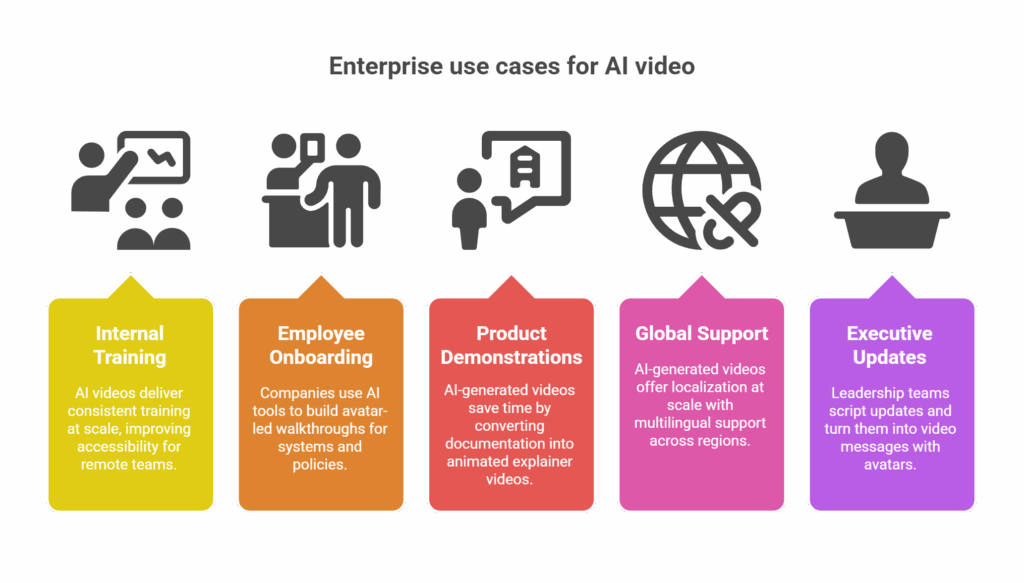Text to Video AI: Revolutionizing How Enterprises Communicate

Key Takeaways
- Text to video AI tools transform written inputs into high-quality, dynamic videos using artificial intelligence.
- Enterprises use AI-generated videos for training, onboarding, product explainers, and scalable customer support.
- Key features for enterprise use include watermark-free exports, avatar and script customization, voice cloning, and API integration.
- Developer teams are embedding AI video generation into internal workflows with real-time rendering and CRM/LMS connectivity.
What Is Text to Video AI?
Text to video AI is a category of generative tools that convert written inputs, like scripts, prompts, or documentation, into dynamic video content. Using a combination of natural language processing, computer vision, and synthetic media generation, these platforms enable users to transform plain text into full-fledged video assets. In most cases, this includes synchronized visuals, voiceovers, and sometimes animated avatars or digital presenters.
Unlike traditional video production, which can be time-intensive and resource-heavy, text to video AI solutions dramatically streamline the process. For enterprise teams, this means faster turnaround times, lower costs, and the ability to scale video production without increasing headcount or technical overhead.
A key strength of these tools is accessibility. Non-technical users can produce professional-quality videos by simply entering a script. In some cases, all it takes is a prompt. With the right platform, businesses can easily create training videos, product explainers, onboarding materials, and customer-facing tutorials, without needing a camera crew or post-production team.
How Enterprises Use Text to Video AI for Scalable Communication

Enterprise communication today extends far beyond email or PowerPoint. Businesses are leaning into video as the default format for internal knowledge sharing and external customer engagement. And AI video generator from text tools are unlocking a new level of efficiency in this transition.
Here are some high-impact use cases:
1. Internal Training and Upskilling
HR and L&D teams use AI-generated videos to deliver consistent training at scale. Whether it’s compliance modules, safety protocols, or DEI programs, video helps ensure knowledge retention and improves accessibility for remote teams.
2. Onboarding New Employees
Instead of relying on static documents or overbooked trainers, companies can use script to video AI tools to build avatar-led walkthroughs for systems, culture, and policies. Each new hire gets the same engaging experience, customized to their role and language.
3. Product Demonstrations and Explainers
Customer success teams often need to explain features or workflows repeatedly. AI-generated videos save time by converting existing documentation or FAQs into short, animated explainer videos, complete with digital spokespeople.
4. Global Support Content
For organizations serving diverse markets, AI-generated videos offer localization at scale. With multilingual support, companies can deliver the same message across languages and regions without duplicating effort.
5. Executive Updates and Announcements
Leadership teams can script updates and have them instantly turned into video messages with lifelike avatars. These videos are perfect for company-wide announcements, especially in distributed or hybrid organizations.
Features to Look for in an Enterprise-Ready AI Video Generator
Not all AI video tools are built with enterprise needs in mind. If you’re looking to integrate this technology across your organization, here are key features to prioritize:
1. Watermark-Free Exports
If you’re producing public-facing or brand-critical content, avoid tools that force their logo onto your final video. Many platforms advertise a free text to video AI without watermark experience, but be sure to verify this across use cases and resolutions. For enterprise use, it’s also important to ensure that exported videos retain full quality without compression or branding overlays, especially for campaigns, investor presentations, or public training materials.
2. Script and Avatar Customization
Look for platforms that support flexible avatar selection or the ability to create avatars from your team members. Customization goes beyond appearance—you should be able to adjust voice style, clothing, gestures, and even emotional tone. Some platforms let you upload a photo to generate a custom avatar, which is useful for creating relatable, recognizable spokespeople for internal and external communications alike.
3. Multilingual Support
An enterprise-ready tool should include native or AI-translated support for multiple languages, with accurate lip sync and voice matching. This allows global teams to maintain a unified brand message while delivering content in the preferred language of their audience. Look for support not only for major languages but also dialects, accents, and region-specific phrasing to increase local engagement.
4. Voice Cloning and TTS Control
High-quality voice options help ensure your video doesn’t sound robotic. Advanced tools allow for voice cloning of real team members, which is especially useful for replicating leadership voices or creating continuity across training programs. TTS (text-to-speech) control should also include pacing, emphasis, pitch, and volume settings to refine delivery and emotional tone.
5. API and Integration Options
Enterprises need tools that can integrate with their existing ecosystems, whether that’s an LMS, CMS, CRM, or customer support platform. An API-first platform is crucial for automating video generation from internal workflows. For example, a knowledge base article update could trigger an updated training video automatically. Integration with platforms like Slack, Salesforce, or SharePoint ensures video is not siloed.
6. Template and Brand Control
From typography and background design to intro/outro slides, choose tools that let you preserve your brand identity. Enterprise-grade solutions should offer reusable templates that comply with brand guidelines, including logo placement, color schemes, and animation styles. This enables marketing, HR, and support teams to create content autonomously while staying visually consistent.
For more on the topic, explore our breakdown of the best enterprise video platforms.
How D-ID Enhances Text to Video AI for Developer Teams
D-ID is built for scale, flexibility, and realism, making it an ideal platform for developers looking to integrate AI video generation into enterprise environments.
API-First Architecture
At the core of D-ID’s platform is a developer-friendly API that allows users to generate videos from text inputs in real time. Whether you’re building a product demo engine, a virtual onboarding bot, or an education module that adapts to user queries, D-ID’s tools can plug directly into your infrastructure.
Real-Time Rendering
With D-ID, video rendering is fast and often measured in seconds. This makes it viable for use cases like just-in-time training, interactive learning platforms, or real-time content personalization. Combine it with a chatbot, and you’ve got a conversational avatar that can explain policies, troubleshoot, or onboard users dynamically.
Flexible Avatar Generation
D-ID offers a range of avatar creation options:
- Upload your own photo to create a digital presenter from a real team member
- Use video to create an Express Avatar for rapid deployment
- Connect a visual agent to a knowledge base to answer any customer questions
- Personalize voice, language, and script tone to match any scenario
Integration With Enterprise Tools
D-ID integrates easily with tools like content management systems, learning management platforms, or video hosting solutions. This makes it simple for teams to embed generated videos into onboarding portals, support wikis, or customer dashboards.
Use Cases in Action:
- Compliance Training: Automatically generate region-specific training videos from shared scripts
- Product Walkthroughs: Let sales teams convert new feature releases into digestible video guides
- AI Assistants: Power your chatbot or customer assistant with a face and voice, adding trust and emotional connection
Building a Smarter Communication Pipeline
The promise of text to video AI goes beyond cost savings. It’s about empowering more people across your organization to communicate clearly, consistently, and creatively. Instead of waiting days or weeks for video production cycles, your team can respond in real time, with quality content that matches your brand.
This technology helps remove silos, reinforce learning, and enhance customer interactions at scale. By combining the natural flow of conversation with the visual power of video, AI brings communication closer to the way humans actually connect.
Whether you’re trying to localize content, train employees faster, or free up your team from repetitive explanations, the right platform can make all the difference.
Ready to Turn Your Scripts Into Video?
D-ID is purpose-built for enterprise teams that need script to video AI tools that are powerful, flexible, and easy to integrate.
- Try the Creative Reality Studio to convert text into video content in minutes
- Connect with our API documentation to build automated video workflows
Or contact our sales team to book an intro call and explore how D-ID can help you scale your message with ease.
FAQs
-
The best text to video AI tools for enterprises combine usability with depth of features. D-ID is a strong option because it supports API-based workflows, high-resolution avatar rendering, multilingual voice synthesis, and brand customization—all essential for scaling communications across departments and regions. Additionally, D-ID’s Creative Reality Studio and real-time rendering make it ideal for everything from HR training to product walkthroughs. Ease of integration with enterprise systems also gives it a competitive edge.
-
Yes, several AI tools allow for watermark-free video generation, though most reserve this feature for paid or enterprise tiers. D-ID offers options to convert script to video free for testing purposes, but watermark-free export is included in business plans. This is important for maintaining professionalism, especially in customer-facing videos or investor presentations. Always confirm that the tool supports HD output and full customization to ensure your final videos meet brand standards.
-
Some platforms offer a watermark-free trial or limited-use plan, which can be great for small teams or testing. However, these plans often come with limitations on export quality, avatar variety, or integration access. For enterprise-grade usage—like training at scale or localization—paid options will generally deliver better performance, reliability, and compliance with branding needs.
-
D-ID sets itself apart through its focus on photorealistic avatars, API-first development, and real-time rendering. Unlike tools that only offer template-driven outputs, D-ID allows full customization over avatars, voices, languages, and branding elements. Developers can plug D-ID into their LMS, CMS, or CRM to trigger automated video generation from scripts or prompts. Combined with multilingual support and voice cloning, D-ID delivers a flexible, enterprise-ready platform that supports both internal communication and external marketing.
-
Development teams can leverage text to video AI in several impactful ways. Common applications include onboarding new engineers, automating product release announcements, and creating dynamic documentation guides. For example, updating a README or changelog could auto-generate a video walkthrough with an avatar. Teams also use AI videos for bug report explanations, internal demos, or async communication across time zones. With D-ID, dev teams gain a scalable way to make technical content more engaging and accessible.
Was this post useful?
Thank you for your feedback!
 Libi Michelson
Libi Michelson